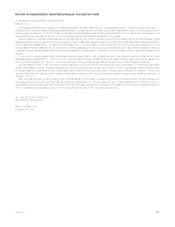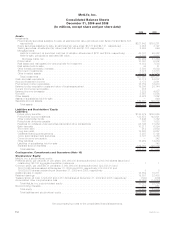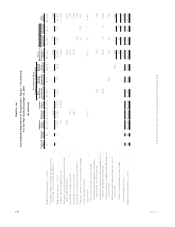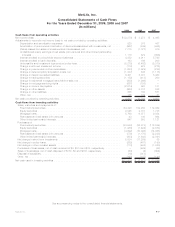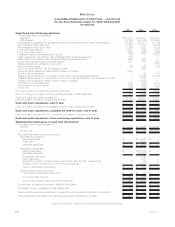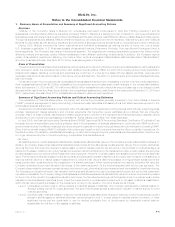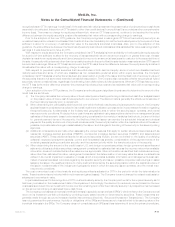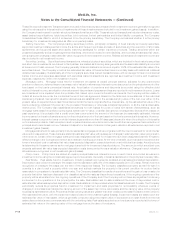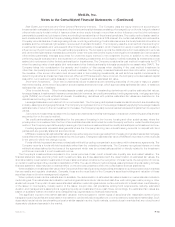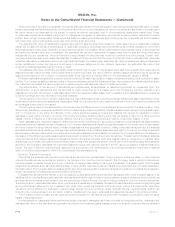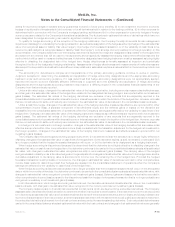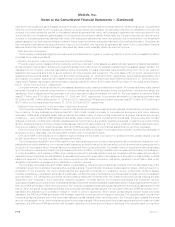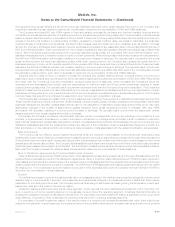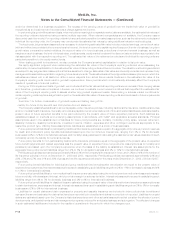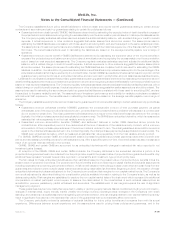MetLife 2009 Annual Report Download - page 95
Download and view the complete annual report
Please find page 95 of the 2009 MetLife annual report below. You can navigate through the pages in the report by either clicking on the pages listed below, or by using the keyword search tool below to find specific information within the annual report.recognized as an OTTI in earnings (“credit loss”). If the estimated fair value is less than the present value of projected future cash flows
expected to be collected, this portion of OTTI related to other-than credit factors (“noncredit loss”) is recorded as other comprehensive
income (loss). There was no change for equity securities which, when an OTTI has occurred, continue to be impaired for the entire
difference between the equity security’s cost and its estimated fair value with a corresponding charge to earnings.
Prior to the adoption of the new OTTI guidance, the Company recognized in earnings an OTTI for a fixed maturity security in an
unrealized loss position unless it could assert that it had both the intent and ability to hold the fixed maturity security for a period of time
sufficient to allow for a recovery of estimated fair value to the security’s amortized cost basis. Also, prior to the adoption of this
guidance, the entire difference between the fixed maturity security’s amortized cost basis and its estimated fair value was recognized in
earnings if it was determined to have an OTTI.
With respect to equity securities, the Company considers in its OTTI analysis its intent and ability to hold a particular equity security
for a period of time sufficient to allow for the recovery of its estimated fair value to an amount equal to or greater than cost. If a sale
decision is made for an equity security and it is not expected to recover to an amount at least equal to cost prior to the expected time of
the sale, the security will be deemed other-than-temporarily impaired in the period that the sale decision was made and an OTTI loss will
be recorded in earnings. When an OTTI loss has occurred, the OTTI loss is the entire difference between the equity security’s cost and
its estimated fair value with a corresponding charge to earnings.
With respect to perpetual hybrid securities that have attributes of both debt and equity, some of which are classified as fixed
maturity securities and some of which are classified as non-redeemable preferred stock within equity securities, the Company
considers in its OTTI analysis whether there has been any deterioration in credit of the issuer and the likelihood of recovery in value of
the securities that are in a severe and extended unrealized loss position. The Company also considers whether any perpetual hybrid
securities, with an unrealized loss, regardless of credit rating, have deferred any dividend payments. When an OTTI loss has occurred,
the OTTI loss is the entire difference between the perpetual hybrid security’s cost and its estimated fair value with a corresponding
charge to earnings.
Upon adoption of the new OTTI guidance, the Company’s methodology and significant inputs used to determine the amount of the
credit loss are as follows:
(i) The Company calculates the recovery value of fixed maturity securities by performing a discounted cash flow analysis based
on the present value of future cash flows expected to be received. The discount rate is generally the effective interest rate of
the fixed maturity security prior to impairment.
(ii) When determining the collectability and the period over which the fixed maturity security is expected to recover, the Company
applies the same considerations utilized in its overall impairment evaluation process which incorporates information regarding
the specific security, fundamentals of the industry and geographic area in which the security issuer operates, and overall
macroeconomic conditions. Projected future cash flows are estimated using assumptions derived from management’s best
estimates of likely scenario-based outcomes after giving consideration to a variety of variables that include, but are not limited
to: general payment terms of the security; the likelihood that the issuer can service the scheduled interest and principal
payments; the quality and amount of any credit enhancements; the security’s position within the capital structure of the issuer;
possible corporate restructurings or asset sales by the issuer; and changes to the rating of the security or the issuer by rating
agencies.
(iii) Additional considerations are made when assessing the unique features that apply to certain structured securities such as
residential mortgage-backed securities (“RMBS”), commercial mortgage-backed securities (“CMBS”) and asset-backed
securities (“ABS”). These additional factors for structured securities include, but are not limited to: the quality of underlying
collateral; expected prepayment speeds; current and forecasted loss severity; consideration of the payment terms of the
underlying assets backing a particular security; and the payment priority within the tranche structure of the security.
(iv) When determining the amount of the credit loss for U.S. and foreign corporate securities, foreign government securities and
state and political subdivision securities, management considers the estimated fair value as the recovery value when available
information does not indicate that another value is more appropriate. When information is identified that indicates a recovery
value other than estimated fair value, management considers in the determination of recovery value the same considerations
utilized in its overall impairment evaluation process which incorporates available information and management’s best esti-
mated of scenarios-based outcomes regarding the specific security and issuer; possible corporate restructurings or asset
sales by the issuer; the quality and amount of any credit enhancements; the security’s position within the capital structure of
the issuer; fundamentals of the industry and geographic area in which the security issuer operates, and the overall mac-
roeconomic conditions.
The cost or amortized cost of fixed maturity and equity securities is adjusted for OTTI in the period in which the determination is
made. These impairments are included within net investment gains (losses). The Company does not change the revised cost basis for
subsequent recoveries in value.
In periods subsequent to the recognition of OTTI on a fixed maturity security, the Company accounts for the impaired security as if it
had been purchased on the measurement date of the impairment. Accordingly, the discount (or reduced premium) based on the new
cost basis is accreted into net investment income over the remaining term of the fixed maturity security in a prospective manner based
on the amount and timing of estimated future cash flows.
The Company purchases and receives beneficial interests in special purpose entities (“SPEs”), which enhance the Company’s total
return on its investment portfolio principally by providing equity-based returns on fixed maturity securities. These investments are
generally made through structured notes and similar instruments (collectively, “Structured Investment Transactions”). The Company
has not guaranteed the performance, liquidity or obligations of the SPEs and its exposure to loss is limited to its carrying value of the
beneficial interests in the SPEs. The Company does not consolidate such SPEs as it has determined it is not the primary beneficiary.
F-11MetLife, Inc.
MetLife, Inc.
Notes to the Consolidated Financial Statements — (Continued)


